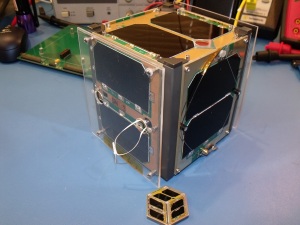
AO-85 (Fox-1A) Flight Unit
AO-85 has been formally commissioned and turned over to AMSAT-NA Operations, who are now responsible for the scheduling and modes.
The following guidelines are provided for users:
Uplink power should be on the order of minimum 200 W EIRP for full quieting at lower antenna elevation angles. Your mileage may vary. With an Arrow, 5 W has been used successfully to make contacts.
Polarity is important. The satellite antennas are linear. So, if you are using linearly polarized antennas, you will need to adjust throughout the pass. Full duplex operation facilitates these adjustments while transmitting and is highly recommended.
The downlink is very strong and should be heard well with almost any antenna.
Downlink audio is 5 kHz deviation, as expected. Many will perceive that the audio is “low.” This is an effect of the filtering below 300 Hz, which provides for the DUV telemetry, coupled with any noise on the uplink signal resulting from lack of full quieting or being off frequency. That makes for less fidelity than a typical receiver in terms of audio frequencies passed.
Transmit (downlink) frequency varies with temperature. Due to the wide range of temperatures we are seeing in the eclipse cycle, the transmitter can be anywhere from around 500 Hz low at 10°C to near 2 kHz low at 40°C.
Receive frequency has been generally agreed to be about 435.170 MHz, although the AFC makes that hard to pin down and also helps with the uplinks that are off frequency.
Probably the most notable observations about AO-85 are an apparent lack of sensitivity and difficulty in turning on the repeater with the 67 Hz CTCSS when it is not yet activated, or holding it on by the presence of the CTCSS. We have determined a probable cause for the sensitivity issue and while that can’t be fixed on AO-85 we are taking steps to prevent similar issues on the rest of the Fox-1 CubeSats. The tone detection threshold along with the receive sensitivity issue makes it hard to bring up the repeater. This is being addressed by adjusting the values for a valid tone detection in the other Fox-1 CubeSats now that we have on orbit information about temperatures and power budget. Full details will be in the Nov/Dec AMSAT Journal.
It is important to remember that science is the reason behind the Fox-1 satellites. Not only does science help with the launch cost, it provides a great amount of educational value both from the science payload and in amateur radio itself. The data-under-voice (DUV) telemetry is an excellent way to provide the science without sacrificing the use of the satellite for communications, which would be the case if higher speed downlinks were needed. DUV provides constant science as long as the repeater is in use, which in turn provides more downlink data for the science – a mutually beneficial combination.
Fox-1A is AMSAT-NA’s first CubeSat. Many new techniques are incorporated and lessons will be learned, as with any new “product.” The Fox-1 Project is a series of CubeSats. A total of five will be built and flown. Launches are scheduled for three more, and a new NASA CubeSat Launch Initiative proposal will be submitted for the fifth. We will incorporate changes from what we learn in each launch, to the extent possible, in subsequent Fox-1 CubeSats.
Of the four NASA sponsored CubeSats on the ELaNa XII launch October 8, we are sad to report that ARC1 was never heard from and BisonSat was lost after a few weeks of operation. AMSAT extends our deepest sympathy to the people who worked so hard on these projects. To our members, we want to say that the Fox Team is very proud and pleased that our first CubeSat is very successful and hopefully will be for some time.
AO-85 information http://amsat-uk.org/satellites/communications/ao-85-fox-1a/
![]()